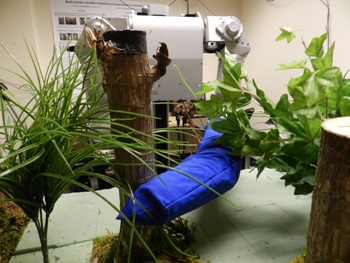Apr 30 2013
Whether reaching for a book out of a cluttered cabinet or pruning a bush in the backyard, a person’s arm frequently makes contact with objects during everyday tasks. Animals do it too, when foraging for food, for example.
 Robots Reaching Through Clutter
Robots Reaching Through Clutter
Much in the same way, robots are now able to intelligently maneuver within clutter, gently making contact with objects while accomplishing a task. This new control method has wide applications, ranging from robots for search-and-rescue operations to assistive robotics for people with disabilities.
“Up until now, the dominant strategies for robot manipulation have discouraged contact between the robot’s arm and the world,” said Charlie Kemp, lead researcher and associate professor in the Coulter Department of Biomedical Engineering at Georgia Tech and Emory University. “Instead of avoiding contact, our approach enables the arm to make contact with objects, people and the rest of the robot while keeping forces low.”
Kemp, director of Georgia Tech’s Healthcare Robotics Lab, his graduate students and researchers at Meka Robotics have developed a control method that works in tandem with compliant robotic joints and whole-arm tactile sensing. This technology keeps the robot’s arm flexible and gives the robot a sense of touch across its entire arm.
With their control method, Kemp’s robots have performed numerous tasks, such as reaching through dense artificial foliage and a cinder block representative of environments that search-and-rescue robots can encounter.
A publication describing the research, “Reaching in clutter with whole-arm tactile sensing,” appears in this month’s edition of the International Journal of Robotics Research.
Kemp's lab also has promising results that could impact the future of assistive robotics. They have developed tactile sensors made out of stretchable fabric that covers the entire arm of a robot. In a preliminary trial with the new control method and sensors, a person with quadriplegia used the robot to perform tasks for himself. He was able to pull a blanket over himself and grab a cloth to wipe his face, all while he was in bed at his home.
This trial was conducted as part of the Robots for Humanity project with Willow Garage. In order to ensure safety, researchers from Kemp’s lab closely monitored the activities. This research has been accepted and will be presented at the International Conference on Rehabilitation Robotics in June.
“I think it’s a good safety feature because it hardly presses against me even when I tell it to,” reported the participant, Henry Evans, after the trial. “It really feels safe to be close to the robot.”
Evans was also impressed by how the robot’s arm “just wriggles around obstacles.”
Kemp’s research team has also released the designs and code for the sensors and controller as open source hardware and software so that researchers and hobbyists can build on the work.
The research is part of an ongoing effort to create a new foundation for robotics, where contact between the robot’s arm and the world is encouraged.
“Our belief is that this approach is the way of the future for robots,” said Kemp, who is also a member of Georgia Tech’s Center for Robotics and Intelligent Machines. “It is going to allow robots to better operate in our homes, our workplaces and other complex environments.”